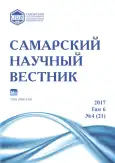Peculiarities of in vitro parthenogenesis of unpollinated maize ovaries
- Authors: Alatortseva T.A.1
-
Affiliations:
- Saratov State University
- Issue: Vol 6, No 4 (2017)
- Pages: 10-13
- Section: 03.02.00 – General Biology
- URL: https://journals.rcsi.science/2309-4370/article/view/22218
- DOI: https://doi.org/10.17816/snv201764101
- ID: 22218
Cite item
Full Text
Abstract
The maize line AT-1 is characterized by a hereditary predisposition to parthenogenesis. The aim of this investigation is to study parthenogenetic embryo development in the culture of unpollinated ovaries in vitro. The unpollinated ovaries were explanted in 1, 3, 5, 7, 10, 15 days after the appearance of stigmas from ears. The nutrient medium included mineral components of MS, vitamins, sucrose (9,0%), 2,4-D (2,0 mg/l), agar-agar. The structure of megagametophytes at the time of inoculation of the ovaries and on the 3rd, 7th, 14th, 21th, 28th day of cultivation was studied. The first divisions of unfertilized egg cells were observed on the 5th–7th day after appearance of stigmas from ears, independently from whether all this time the ovaries were on the mother plant or they were inoculated into the nutrient medium. The formation of the autonomous abnormal endosperm in some cultivated ovaries was detected. The abnormal endosperm disturbed normal development of the proembryo. As a rule, the ovaries with embryo and endosperm degenerated. In the absence of endosperm, the morphogenesis of parthenogenetic proembryos was carried out in one of two directions in vitro: 1) development of plants by direct embryogenesis; 2) regeneration of plants from numerous embryoids, raised on the surface of globular proembryos. The second direction was prevailed. The culture of unpollinated ovaries can be a promising method of mass haploid regenerants not only in maize, but also in other types of agricultural plants.
Full Text
##article.viewOnOriginalSite##About the authors
Tatyana Alekseevna Alatortseva
Saratov State University
Author for correspondence.
Email: alatortsevata@mail.ru
candidate of biological sciences, associate professor of Chair of Genetics
Russian Federation, SaratovReferences
- Павлова М.К. Культура неоплодотворенных завязей и семяпочек: возможности и перспективы // Сельскохозяйственная биология. 1987. № 1. С. 27-31.
- Бугара А.М., Русина Л.В. Культура неоплодотворенных завязей и семяпочек как способ получения гаплоидных растений // Физиология и биохимия культурных растений. 1988. Т. 20, № 5. С. 419-430.
- Truong-Andre I., Demarly Y. Obtaining plants by in vitro culture of unfertilized maize ovaries (Zea mays L.) and preliminary studies on the progeny of a gynogenetic plant // Z. Pflanzenzüchtg. 1984. № 92. P. 309-320.
- Ao G.M., Zhao S.X., Li G.H. Induction of haploid plantlets from unpollinated maized ovaries in ovaries in vitro // Acta Genetica Sinica. 1982. Vol. 9, № 4. P. 281-283.
- Alatortseva T.A., Tyrnov V.S. Reproducing of haploid and diploid maize forms in vitro // Maize Genet. Coop News. Lett. 2001. № 75. P. 55-56.
- Tang F., Tao Y., Zhao T.Y., Wang G. In vitro production of haploid and doubled haploid plants from pollinated ovaries of maize (Zea mays) // Plant Cell. Tissue and Organ Culture. 2006. Vol. 84, Iss. 2. P. 233-237.
- Тырнов В.С., Еналеева Н.Х. Автономное развитие зародыша и эндосперма у кукурузы // Докл. АН СССР. 1983. Т. 272, № 3. С. 722-723.
- Murashige Т., Skoog F. A revised medium for rapid growth and bioassays with tobacco cultures // Physiol. Plant. 1962. Т. 15, № 3. С. 473-497.
- Куприянов П.Г. Ускоренные методы исследования зародышевого мешка // Выявление апомиктичных форм во флоре цветковых растений СССР. Саратов, 1978. С. 155-163.
- Паушева З.П. Практикум по цитологии растений. М.: Колос, 1970. 255 с.
- Камелина О.Н., Проскурина О.Б., Жинкина Н.А. К методике окраски эмбриологических препаратов // Бот. журн. 1992. Т. 77, № 4. С. 93-96.
- Алаторцева Т.А., Апанасова Н.В., Лобанова Л.П. Явление полиэмбрионии in vivo и in vitro у апомиктичной линии кукурузы // Изв. Сарат. ун-та. Нов. сер. Сер.: Химия. Биология. Экология. 2017. Т. 17, вып. 4. С. 398-405.
- Kuo C.-s., Lu W.-l. Изучение морфологии и цитологии эмбриоидов, полученных в культуре каллюса кукурузы // Чжиу сюэ-бау. Acta. Bot. Sin. 1984. Vol. 26, № 1. P. 19-23.
- Lupotto E. In vitro culture of isolated somatic embryos of maize (Zea mays L.) // Maydica. 1986. Vol. 31, № 2. P. 197-201.
- Vasil V., Vasil I.K. Plant regeneration from friable embryogenic callus and cell suspension cultures of Zea mays L. // Plant. Physiol. 1986. Vol. 124, № 5. P. 399-408.
- Wang A.S. Callus induction and plant regeneration from maize mature embryos // Plant. Cell Reports. 1987. № 6. P. 360-362.
- Lupotto E., Lusardi M.C. Secondary somatic embryogenesis from regenerating plantlets of the inbred line B79 of maize (Zea mays L.). Switch from type 1 to type 2 callus and effect on the regenerative potential // Maydica. 1988. Vol. 33, № 3. P. 167-177.
- Van Lammeren A.A.M. Obsevations on the structural development of immature maize embryos (Zea mays L.) during in vitro culture in the presence or absence of 2,4-D // Acta. Bot. Neerl. 1988. Vol. 37, № 1. P. 49-61.
- McCain J.W., Hodges T.K. Anatomy of somatic embryos from maize embryo cultures // Bot. Gaz. 1986. Vol. 147, № 4. P. 453-456.
- Митрофанова И.В. Соматический эмбриогенез как система in vitro размножения культурных растений // Физиол. и биохим. культ. растений. 2009. Т. 41, № 6. С. 495-508.
- Терехин Э.С. Паразитные цветковые растения: эволюция онтогенез и образ жизни. Л.: Изд-во «Наука», 1977. 220 с.
- Батыгина Т.Б., Бутенко Р.Г. Морфогенетический потенциал зародышей покрытосеменных растений (на примере рода Paeonia сем. Paeoniaceae) // Бот. журн. 1981. Т. 66, № 11. С. 1532-1548.
Supplementary files









